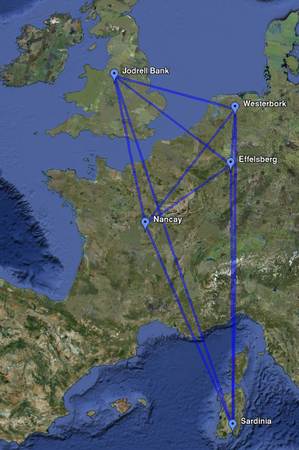Astronomers
LEAP
THE LARGE EUROPEAN ARRAY FOR PULSARS
The Large European Array for Pulsars (LEAP) project performs simultaneous observations of millisecond pulsars at 5 large European radio telescopes: the Lovell telescope at Jodrell Bank Observatory (UK), the Westerbork Synthesis Radio Telescope (Netherlands), the Effelsberg Telescope (Germany), the Nançay Radio Telescope (France) and the Sardinia Radio Telescope (Italy). This project is part of the European Pulsar Timing Array (EPTA)'s effort to directly detect gravitational waves from supermassive black hole binaries using an array of millisecond pulsars. By observing pulsars simultaneously, baseband data from each telescope can be added coherently in phase, which leads to a greater increase in the signal-to-noise of the observed pulsars. Observing pulsars with LEAP is equivalent to observing with a single dish of 196 meters in diameter, which is similar to the illuminated area of the Arecibo dish, but with a larger range of observable declinations.
The Sardinia Radio Telescope (SRT) is the latest telescope to join the LEAP effort. LEAP observations started in early 2012 with the Effelsberg and Westerbork telescopes, and were joined later that year by the Lovell and Nançay telescopes. Observations are performed monthly and are 25 hours long. The participation of SRT in LEAP was made possible once the dual-band L/P receiver was installed at the primary focus of the telescope (June 2013) and the ROACH (Reconfigurable Open Architecture Computing Hardware) backend was installed on-site (July 2013). The first LEAP session was conducted on July 27, 2013 for one pulsar (PSR J1022+1001) and one 16 MHz sub-band, which was observed simultaneously at all 5 telescopes. Since March 2014, we can record baseband data in 8 x 16-MHz sub-bands, covering the full 128 MHz LEAP bandwidth (1332-1460 MHz), thanks to an 8-node CPU cluster that was installed on site.
 |
LEAP data has been collected monthly at the SRT since March 2014. SRT data was included in the first collaboration-wide LEAP paper: Bassa et al. (2016). The implementation of the LEAP project at SRT was described here: Perrodin et al. (2016). The figure represents the LEAP network and "baselines". |
